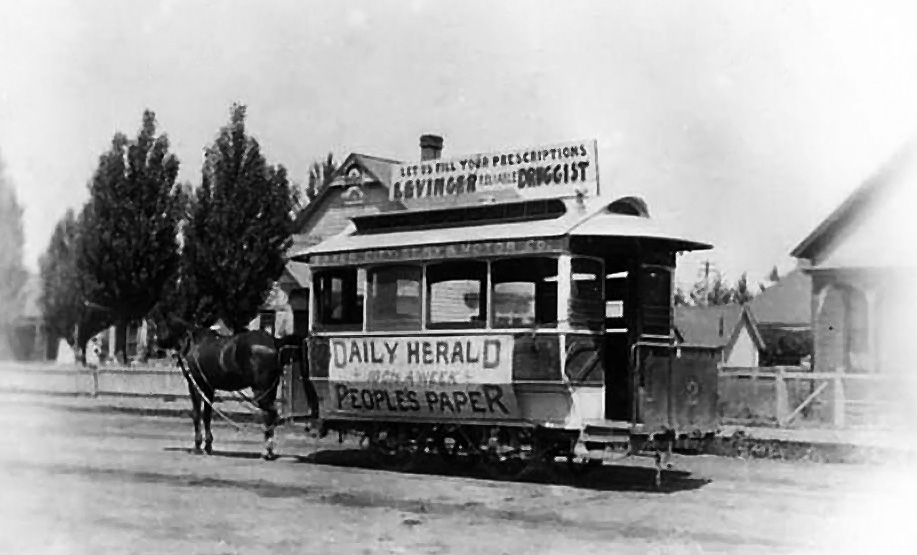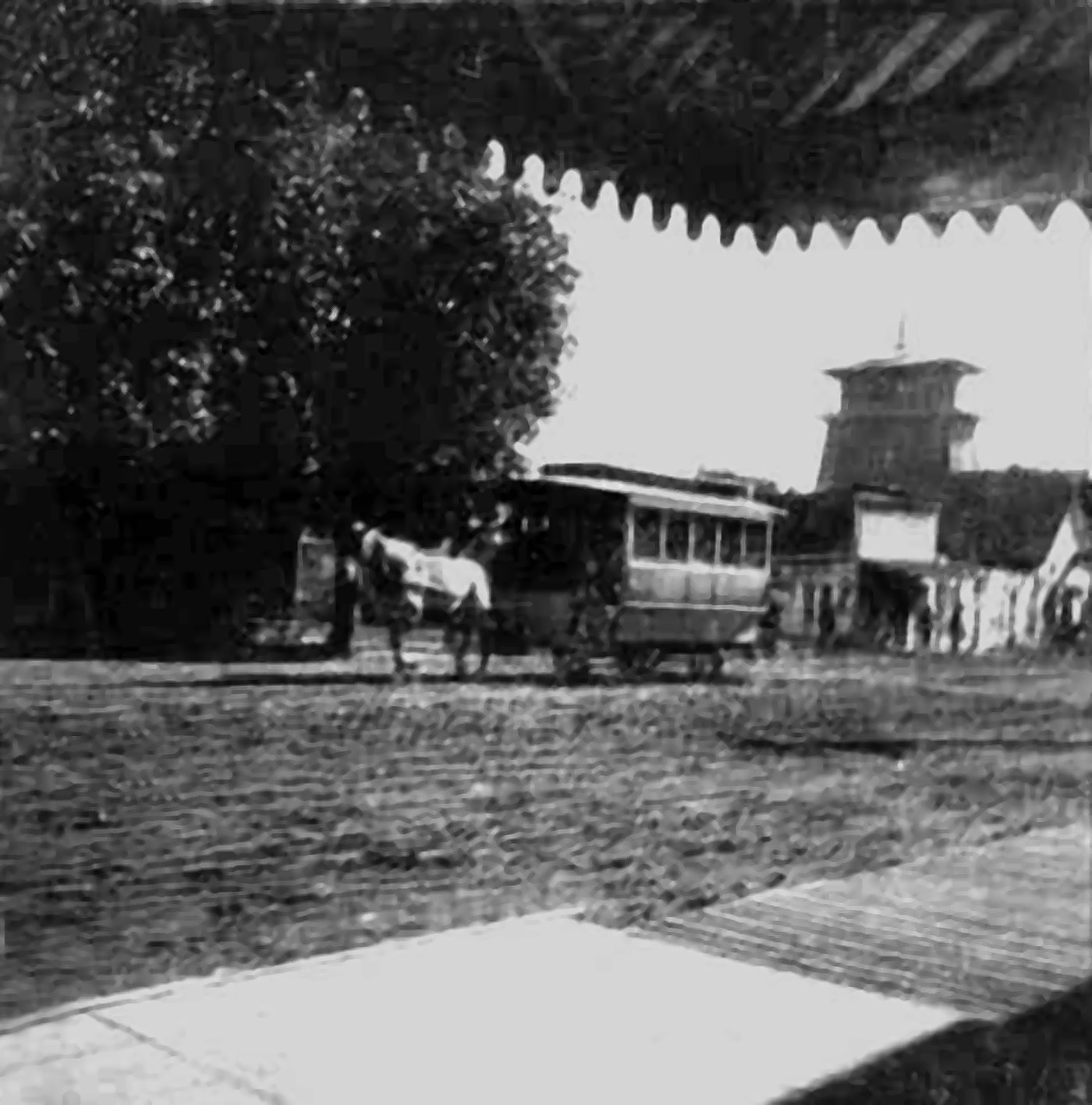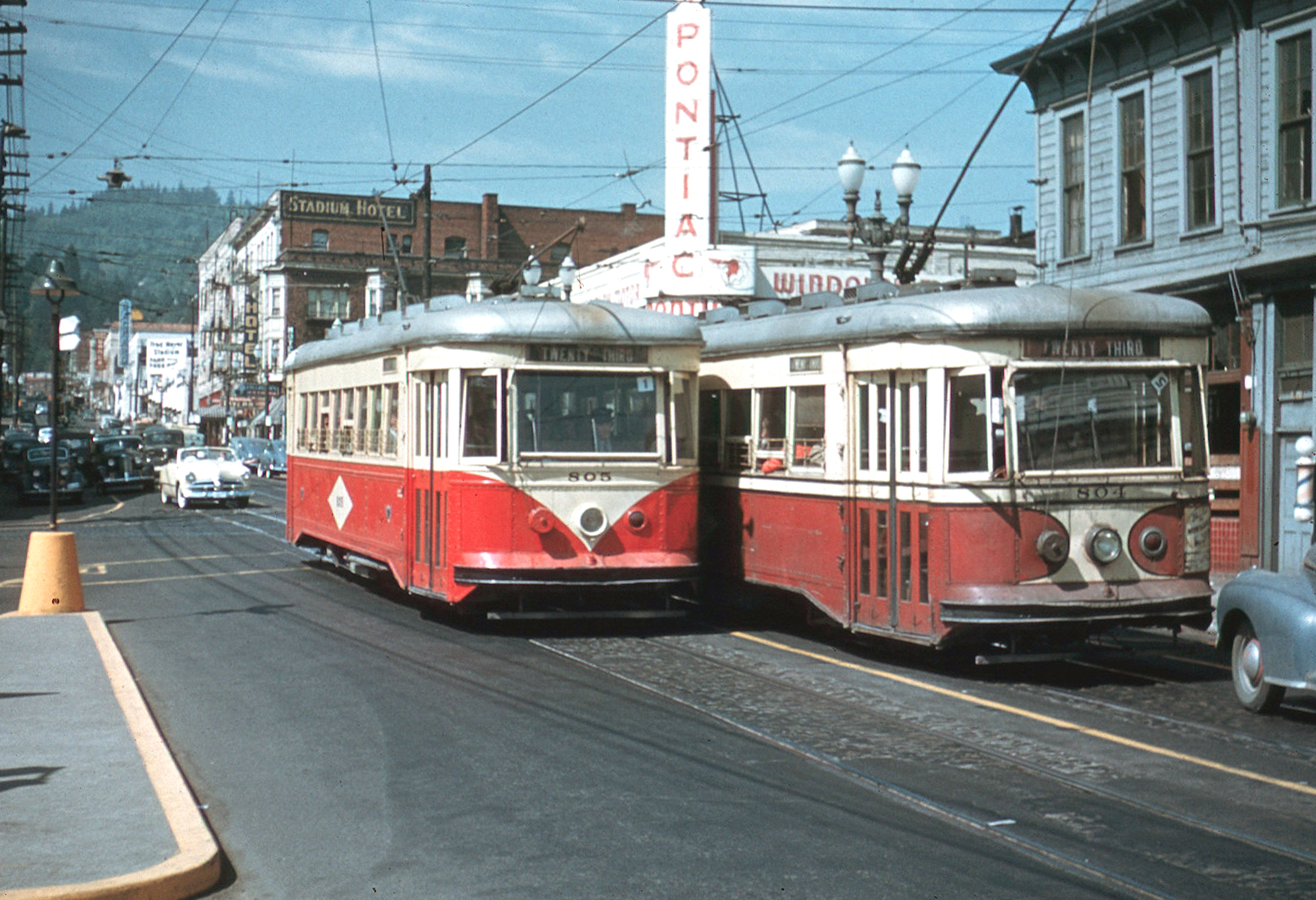The Astoria Street Railway Company began horsecar operations on May 9, 1888. Five cars provided service over three miles of track along Commercial Street. By 1892, the threat of competition from proposed electric lines, a steam motor line, and a cable-car system had inspired the railway to convert to an electric operation. Four horsecars were rebuilt with two fifteen horsepower motors.
The cable railway idea was never realized; but on June 23, 1890, Judge Frank Taylor’s Bay Railway Company began operating a steam dummy line around Smith’s Point. The line ran from the western boundary of town, near present-day Washington and Astor Streets, to new tracts along Young’s Bay, some three miles distant.
The Bay Railway hoped to electrify and build eastward through Astoria. Instead, on April 22, 1895, it was acquired by the Astoria & Columbia River Railroad, which desired its right-of-way for branches running across Young’s Bay to Fort Stevens and Seaside.
The Astoria Street Railway went bankrupt in 1899 and was reorganized on March 2, 1900, by the General Electric Company as the Astoria Electric Railway. GE parent, Thomson-Houston Electric, was creditor for equipment used to electrify the line in 1892. Astoria Electric bought seven new trolleys, including Brill semi-convertibles in which the upper and lower window sash could be raised into pockets in the roof and stored there during warm weather. Such cars were intended to supplant separate fleets of open or closed trolleys that had to be swapped when the weather changed. According to a trade journal the Astoria Electric Railway was the last road to receive semi-convertible streetcars.
In 1910, the Astoria Electric Railway became part of the Pacific Power & Light Company (PP&L), which expanded the system to 5.7 miles and added six new streetcars. In 1913, PP&L realigned tracks to the eastern terminus in Alderwoood to reach Bond Street at Forty-fifth Avenue. A final extension was added at the opposite end of town in 1915, with a line that ran up the hill to Alameda Avenue and Bristol Street.
Unfortunately, the Great Fire of 1922 destroyed the plank streets carrying tracks through the business district, splitting the system. PP&L determined that it would not be cost effective to rebuild tracks through ten downtown blocks, so operations limped along over the two separated track sections until Astoria Transit Company buses took over on June 30, 1924.
-
![Colored postcard showing trolley on Commercial St., Astoria.]()
Astoria streetcar, colored postcard, 1910s.
Colored postcard showing trolley on Commercial St., Astoria. Courtesy Mark Moore
-
![Astoria Street Railway No. 1, East Astoria, 1901.]()
Astoria streetcar, Astoria St Ry no 1, 1901.
Astoria Street Railway No. 1, East Astoria, 1901. Courtesy Richard Thompson
-
![Astoria streetcar map.]()
Astoria streetcar map.
Astoria streetcar map. Courtesy Richard Thompson
-
![Astoria Street Railway horsecar No. 3 passing Clatsop Mill, at what is now 24th and Exchange Sts.]()
Astoria streetcar, horsecar 3.
Astoria Street Railway horsecar No. 3 passing Clatsop Mill, at what is now 24th and Exchange Sts. Courtesy Ed Culp
-
Astoria streetcar, at brewery, late 1890s.
Astoria Street Railway No 8, on what is now Marine Dr. in front of Northern Pacific Brewery, late 1890s. Courtesy Ed Culp
-
![Facsimile of Bay Railway timecard, Sep. 12, 1890.]()
Astoria streetcar, Bay Railway Timecard, 1890.
Facsimile of Bay Railway timecard, Sep. 12, 1890. Daily Astorian newspaper, courtesy Richard Thompson
-
![Astoria Electric Railway cars 6 and 7 at Clatsop County Courthouse, Commercial St.]()
Astoria streetcar, at Clatsop Courthouse.
Astoria Electric Railway cars 6 and 7 at Clatsop County Courthouse, Commercial St. Courtesy Bob Wenzel
-
![Astoria Street Railway trolley No. 3 plunged into the river July 18, 1901.]()
Astoria streetcar, in river, Jul 1901.
Astoria Street Railway trolley No. 3 plunged into the river July 18, 1901. Courtesy Walt Grande
-
![Astoria Street Railway No. 5 at 14th and Commercial Sts., about 1905.]()
Astoria streetcar, 14th and Commercial, ca 1905.
Astoria Street Railway No. 5 at 14th and Commercial Sts., about 1905. Courtesy Richard Thompson
-
![Astoria Electric Railway trolley No. 12 on the Alameda line, late 1910s.]()
Astoria streetcar, trolley 12 on Alameda line, late 1910s.
Astoria Electric Railway trolley No. 12 on the Alameda line, late 1910s. Courtesy Mitch Mitchum
-
![Pacific Power and Light Co. No. 14, with motorman Eli McConkey (r), after 1914.]()
Astoria streetcar, PPL 14 next to sawmill.
Pacific Power and Light Co. No. 14, with motorman Eli McConkey (r), after 1914. Courtesy Bob Wenzel
-
![Bay Railway steam dummy No. 1 with Pullman built coaches 1 and 2.]()
Astoria streetcar, Bay Railway dummy 1, neg 13254.
Bay Railway steam dummy No. 1 with Pullman built coaches 1 and 2. Oreg. Hist. Soc. Research Lib., neg 13254
-
![Pacific Power and Light Co. car No. 7, Feb 1921.]()
Astoria streetcar, PPL car 7, Feb 1921.
Pacific Power and Light Co. car No. 7, Feb 1921. Courtesy Bob Wenzel
-
![Pacific Power and Light Co. trolleys 15, 7, 8, and 5 lined up outside carbarn after Dec. 8, 1922 fire.]()
Astoria Streectar, PPL trolleys after Dec 1922 fire.
Pacific Power and Light Co. trolleys 15, 7, 8, and 5 lined up outside carbarn after Dec. 8, 1922 fire. Courtesy Richard Thompson
Related Entries
-
![Albany streetcar system]()
Albany streetcar system
The Albany Street Railway Company began operation on August 30, 1889, w…
-
![Astoria and Columbia River Railroad]()
Astoria and Columbia River Railroad
Ever since Astoria was founded at the mouth of the Columbia River in 18…
-
![Baker City streetcar system]()
Baker City streetcar system
The Baker City Street Railway Company began operation on June 4, 1890, …
-
![Corvallis streetcar system]()
Corvallis streetcar system
On December 17, 1889, a group of real estate developers, led by Zephen …
-
![Fort Stevens]()
Fort Stevens
One of the three major forts designed to protect the mouth of the Colum…
-
![Portland streetcar system]()
Portland streetcar system
The majority of Portland’s oldest neighborhoods owe their location and …
Related Historical Records
Map This on the Oregon History WayFinder
The Oregon History Wayfinder is an interactive map that identifies significant places, people, and events in Oregon history.
Further Reading
Dennon, Jim. “Astoria’s Streetcars” (part 1). Clatsop County Historical Society Quarterly 9:2 (Spring 1989), 24–36.
Dennon, Jim. “Astoria’s Streetcars” (part 2). Clatsop County Historical Society Quarterly 9:3 (Summer 1989).
Thompson, Richard. Lost Oregon Streetcars. Charleston, SC: History Press, 2017.























